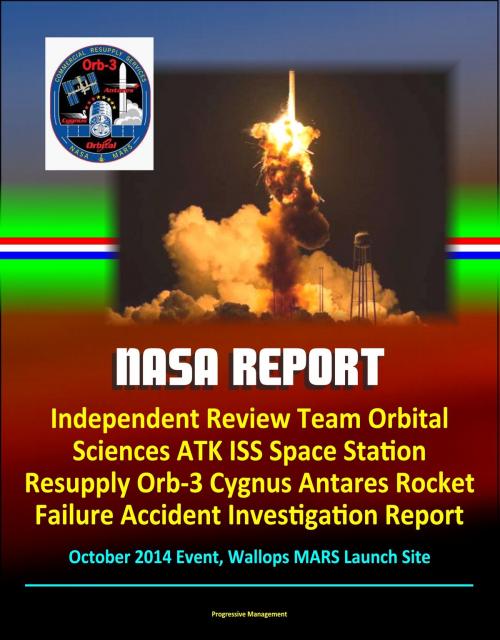NASA Report: Independent Review Team Orbital Sciences ATK ISS Space Station Resupply Orb-3 Cygnus Antares Rocket Failure Accident Investigation Report, October 2014 Event, Wallops MARS Launch Site
Nonfiction, Science & Nature, Technology, Aeronautics & Astronautics, Science, Physics, Astrophysics & Space Science| Author: | Progressive Management | ISBN: | 9781310658464 |
| Publisher: | Progressive Management | Publication: | October 31, 2015 |
| Imprint: | Smashwords Edition | Language: | English |
| Author: | Progressive Management |
| ISBN: | 9781310658464 |
| Publisher: | Progressive Management |
| Publication: | October 31, 2015 |
| Imprint: | Smashwords Edition |
| Language: | English |
Professionally converted for accurate flowing-text e-book format reproduction, this NASA report, released in October 2015, provides the findings of the independent review team of the Orbital Sciences ATK Orb-3 ISS Space Station resupply mission failure, October 28, 2014. At approximately 6:22 p.m. Eastern Daylight Time, Orbital ATK launched its Orb-3 cargo resupply mission bound for the ISS from the Mid-Atlantic Regional Spaceport, which is located on the eastern shore of NASA's Wallops Flight Facility in Virginia. The Orb-3 mission consisted of an Orbital ATK Antares-130 launch vehicle and a standard Cygnus spacecraft loaded with approximately 2296 kg (5057 lbs) of pressurized cargo. Orb-3 was Orbital ATK's third cargo delivery mission under their ISS CRS contract.
Just over 15 seconds into flight an explosion in the Antares Main Engine System (MES) occurred, causing the vehicle to lose thrust and fall back toward the ground. Just prior to Antares impacting the ground, range safety personnel issued a destruct command to the Flight Termination System to minimize the potential damage from the expected ground impact and ensuing explosion of the vehicle. The launch vehicle impacted near the launch pad resulting in loss of the vehicle and cargo. Although there was damage to the launch pad and adjacent facilities and buildings, there were no injuries to members of the public or workers involved in the launch.
The IRT performed detailed analysis and review of Antares telemetry collected prior to and during the launch, as well as photographic and video media capturing the launch and failure. Based on this analysis, the IRT determined that the proximate cause of the Antares launch vehicle failure was an explosion within the AJ26 rocket engine installed in the Main Engine 1 position. Specifically, there was an explosion in the E15 Liquid Oxygen (LO2) turbopump, which then damaged the AJ26 rocket engine designated E16 installed in the Main Engine 2 position. The explosion caused the engines to lose thrust, and the launch vehicle fell back to Earth and impacted the ground, resulting in total destruction of the vehicle and its cargo. The AJ26 engine used for Antares is based on a core Russian NK-33 rocket engine designed and manufactured in the early 1970s in support of the Russian N-1 moon program. Aerojet-Rocketdyne modifies the NK-33 configuration for use on U.S. launch vehicles. For Antares, the AJ26 also includes several operational variations from the NK-33 operations originally intended for the N-1 program, such as but not limited to operation at a higher power level and engine gimballing.
Professionally converted for accurate flowing-text e-book format reproduction, this NASA report, released in October 2015, provides the findings of the independent review team of the Orbital Sciences ATK Orb-3 ISS Space Station resupply mission failure, October 28, 2014. At approximately 6:22 p.m. Eastern Daylight Time, Orbital ATK launched its Orb-3 cargo resupply mission bound for the ISS from the Mid-Atlantic Regional Spaceport, which is located on the eastern shore of NASA's Wallops Flight Facility in Virginia. The Orb-3 mission consisted of an Orbital ATK Antares-130 launch vehicle and a standard Cygnus spacecraft loaded with approximately 2296 kg (5057 lbs) of pressurized cargo. Orb-3 was Orbital ATK's third cargo delivery mission under their ISS CRS contract.
Just over 15 seconds into flight an explosion in the Antares Main Engine System (MES) occurred, causing the vehicle to lose thrust and fall back toward the ground. Just prior to Antares impacting the ground, range safety personnel issued a destruct command to the Flight Termination System to minimize the potential damage from the expected ground impact and ensuing explosion of the vehicle. The launch vehicle impacted near the launch pad resulting in loss of the vehicle and cargo. Although there was damage to the launch pad and adjacent facilities and buildings, there were no injuries to members of the public or workers involved in the launch.
The IRT performed detailed analysis and review of Antares telemetry collected prior to and during the launch, as well as photographic and video media capturing the launch and failure. Based on this analysis, the IRT determined that the proximate cause of the Antares launch vehicle failure was an explosion within the AJ26 rocket engine installed in the Main Engine 1 position. Specifically, there was an explosion in the E15 Liquid Oxygen (LO2) turbopump, which then damaged the AJ26 rocket engine designated E16 installed in the Main Engine 2 position. The explosion caused the engines to lose thrust, and the launch vehicle fell back to Earth and impacted the ground, resulting in total destruction of the vehicle and its cargo. The AJ26 engine used for Antares is based on a core Russian NK-33 rocket engine designed and manufactured in the early 1970s in support of the Russian N-1 moon program. Aerojet-Rocketdyne modifies the NK-33 configuration for use on U.S. launch vehicles. For Antares, the AJ26 also includes several operational variations from the NK-33 operations originally intended for the N-1 program, such as but not limited to operation at a higher power level and engine gimballing.















